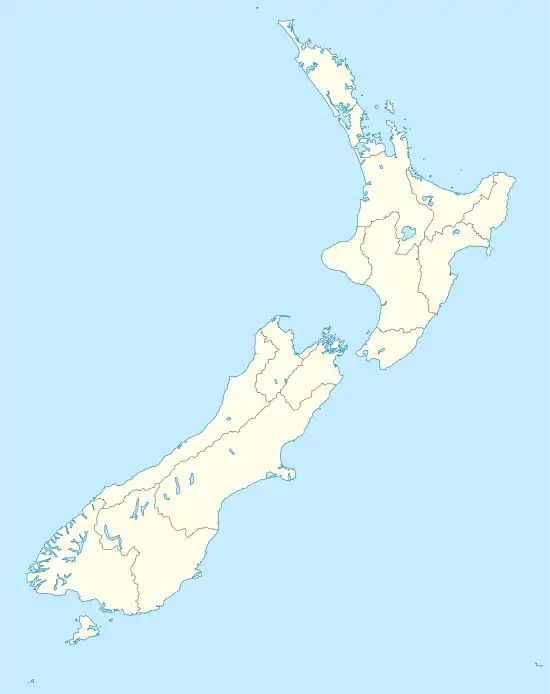2023 FIFA Women's World Cup
The 2023 FIFA Women's World Cup (Māori: 2023 FIFA Wāhine O Te Ao) is scheduled to be the 9th edition of the FIFA Women's World Cup, the quadrennial world championship for women's national football teams organised by FIFA. The tournament will be jointly hosted by Australia and New Zealand, during a reserved period in the FIFA Women's International Match Calendar between 10 July and 20 August 2023.[1] The 2023 tournament will see the Women's World Cup expanded from 24 to 32 teams.
| 2023 FIFA Wāhine O Te Ao Australia/New Zealand 2023 | |
|---|---|
 Bid logo | |
| Tournament details | |
| Host countries | Australia New Zealand |
| Dates | 10 July – 20 August |
| Teams | 32 (from 6 confederations) |
| Venue(s) | 13 proposed (in 12 host cities) |
The United States are the defending champions going into the competition, having won the previous two tournaments in 2015 and 2019.
Host selection
FIFA announced that bidding had begun for the 2023 FIFA Women's World Cup on 19 February 2019.[2] Member associations interested in hosting the tournament had to submit a declaration of interest by 15 March 2019, and provide the completed bidding registration by 16 April 2019. However, FIFA revised the bidding timeline as the tournament expanded to 32 teams on 31 July 2019.[3] Other member associations interested in hosting the tournament now had until 16 August 2019 to submit a declaration of interest, while the completed bidding registration of new member associations and re-confirmation of prior bidders was due by 2 September 2019.[4]
Nine countries initially indicated interest in hosting the events: Argentina, Australia, Bolivia, Brazil, Colombia, Japan, South Korea (with interest in a joint bid with North Korea), New Zealand and South Africa.[5] Belgium expressed interest in hosting the tournament following the new deadline but later dropped out with Bolivia in September 2019.[6][7] Australia and New Zealand later announced they would merge their bids in a joint submission.[8] Brazil, Colombia, and Japan joined them in submitting their bid books to FIFA by 13 December 2019.[9] However, both Brazil and Japan later withdrew their bids in June 2020 before the final voting.[10][11]
On 25 June 2020, Australia and New Zealand officially won the bid to host the Women's World Cup.[12] The decision came after a vote by the FIFA Council, with the winning bid earning 22 votes, while Colombia earned 13.[13] Neither country had previously hosted a senior FIFA tournament. It is the first Women's World Cup to be hosted in multiple countries, and only the second World Cup tournament to do so, following the 2002 FIFA World Cup. It is also the first FIFA Women's World Cup held in the southern hemisphere, the first senior FIFA tournament to be held in Oceania, and the first FIFA tournament to be hosted across multiple confederations (with Australia in the AFC and New Zealand in the OFC). Australia is the second association from the AFC to host the Women's World Cup, after China in both 1991 and 2007.
Format
In July 2019, FIFA President Gianni Infantino proposed an expansion of the Women's World Cup from 24 to 32 teams, starting with the 2023 edition, and doubling the tournament's prize money.[14] The proposal came following the success of the 2019 FIFA Women's World Cup and the prior edition of the tournament in 2015, which after increasing from 16 to 24 teams set an attendance record for all FIFA competitions besides the men's FIFA World Cup.[15] Expanding the tournament to allow an eight additional participating teams gave more member associations a greater opportunity to qualify for the final tournament. This fostered the growing reach and professionalisation of the women's game.[16]
On 31 July 2019, the FIFA Council unanimously decided to expand the tournament to 32 teams, featuring eight groups of four.[3]
The astounding success of this year's FIFA Women's World Cup in France made it very clear that this is the time to keep the momentum going and take concrete steps to foster the growth of women's football. I am glad to see this proposal becoming a reality.
The tournament opens with a group stage consisting of eight groups of four teams, with the top two teams progressing from each group to a knockout tournament starting with a round of 16 teams. The number of games played overall increases from 52 to 64. The tournament replicates the format of the FIFA World Cup used between 1998 and 2022.
Qualification
Australia and New Zealand automatically qualify for the tournament as co-hosts. Qualifying matches expect to start in early 2021 and end in late 2022. The slot allocation was approved by the Bureau of the FIFA Council on 24 December 2020. The slots for the host nations, Australia and New Zealand, were taken directly from the quotas allocated to their confederations, the AFC and OFC respectively.[17]
- AFC (Asia): 5 slots + 1 host slot (Australia)
- CAF (Africa): 4 slots
- CONCACAF (North America, Central America and the Caribbean): 4 slots
- CONMEBOL (South America): 3 slots
- OFC (Oceania): 0 slots + 1 host slot (New Zealand)
- UEFA (Europe): 11 slots
- Play-off tournament: 3 slots
A ten-team play-off tournament will decide the final three spots at the Women's World Cup. The play-off slot allocation is as follows:
- AFC (Asia): 2 slots
- CAF (Africa): 2 slots
- CONCACAF (North America, Central America and the Caribbean): 2 slots
- CONMEBOL (South America): 2 slots
- OFC (Oceania): 1 slot
- UEFA (Europe): 1 slot
On 9 December 2019, the World Anti-Doping Agency initially handed Russia a four-year ban from all major sporting events, after Russian Anti-Doping Agency (RUSADA) was found non-compliant for handing over manipulated laboratory data to investigators.[18] However, the Russia national team could still enter qualification, as the ban only applies to the final tournament to decide the world champions. The WADA ruling allowed athletes who were not involved in doping or the coverup to compete; however, a team representing Russia that uses the Russian flag and anthem cannot participate under the WADA decision.[19] The decision was appealed to the Court of Arbitration for Sport,[20] which upheld WADA's ban but reduced it to two years.[21] The CAS ruling also allowed the name "Russia" to be displayed on uniforms if the words "Neutral Athlete" or "Neutral Team" have equal prominence.[22] If Russia qualifies for the tournament, its female players will be able to use their country's name, flag or anthem at the Women's World Cup, unlike their male counterparts, as the ban will expire on 16 December 2022.[22][23]
Venues
Australia and New Zealand proposed 13 possible venues across 12 host cities for the tournament in the bid book submitted to FIFA, suggesting a minimum of 10 stadiums be used—five in each country.[24] FIFA will decide the final selection of venues. Eden Park in Auckland was suggested to host the opening game, with Stadium Australia in Sydney proposed for the 2023 Women's World Cup final match.[25]
Australia
| Sydney | Brisbane | Melbourne | |
|---|---|---|---|
| Stadium Australia | Sydney Football Stadium | Lang Park (Brisbane Stadium) |
Melbourne Rectangular Stadium |
| Capacity: 83,500 | Capacity: 45,000 (under construction) |
Capacity: 52,500 | Capacity: 30,050 |
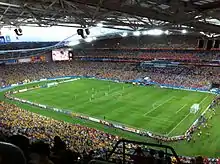 |
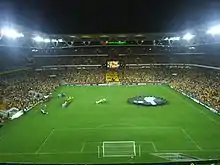 |
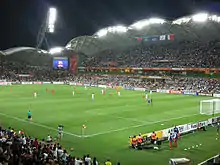 | |
| Newcastle | Perth | ||
| Newcastle Stadium | Perth Rectangular Stadium | ||
| Capacity: 33,000 | Capacity: 22,500 | ||
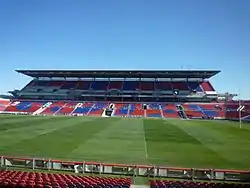 |
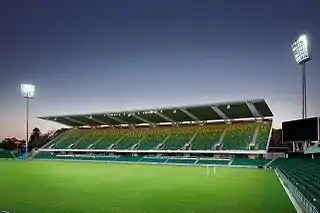 | ||
| Launceston | Adelaide | ||
| York Park | Hindmarsh Stadium | ||
| Capacity: 21,000 | Capacity: 16,500 | ||
 |
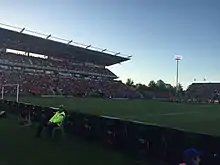 | ||
New Zealand
| Auckland | Wellington | Dunedin | Hamilton |
|---|---|---|---|
| Eden Park | Wellington Stadium | Dunedin Stadium | Waikato Stadium |
| Capacity: 50,000 | Capacity: 34,500 | Capacity: 30,748 | Capacity: 25,800 |
.jpg.webp) |
.jpg.webp) |
.jpg.webp) |
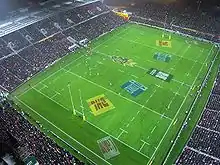 |
| Christchurch | New Zealand candidate cities | ||
| Christchurch Stadium | |||
| Capacity: 18,000 | |||
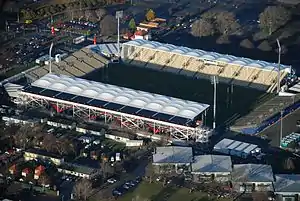 | |||
Broadcasting rights
 Argentina – Televisión Pública TyC Sports
Argentina – Televisión Pública TyC Sports.svg.png.webp) Australia – SBS
Australia – SBS Brazil – Rede Globo, SporTV
Brazil – Rede Globo, SporTV.svg.png.webp) Canada – CTV, TSN, RDS[26]
Canada – CTV, TSN, RDS[26] Chile – Chilevisión
Chile – Chilevisión China – CCTV
China – CCTV United States – Fox, Telemundo[27][28]
United States – Fox, Telemundo[27][28] United Kingdom – BBC, ITV
United Kingdom – BBC, ITV France – TF1
France – TF1 Germany – ARD, ZDF
Germany – ARD, ZDF Spain – Gol
Spain – Gol Sweden – NENT[29]
Sweden – NENT[29] New Zealand – Sky Sport
New Zealand – Sky Sport Norway – NENT[29]
Norway – NENT[29] Denmark – NENT[29]
Denmark – NENT[29] Finland - YLE[30]
Finland - YLE[30]
References
- "Women's international match calendar 2020–2023" (PDF). FIFA.com. Fédération Internationale de Football Association. 6 November 2018. p. 8. Retrieved 24 July 2019.
- "FIFA starts bidding process for FIFA Women's World Cup 2023". FIFA.com. Fédération Internationale de Football Association. 19 February 2019.
- "FIFA Council unanimously approves expanded 32-team field for FIFA Women's World Cup". FIFA.com. Fédération Internationale de Football Association. 31 July 2019. Retrieved 31 July 2019.
- "FIFA Women's World Cup 2023: Overview of the bidding process (updated version, August 2019)" (PDF). FIFA.com. Fédération Internationale de Football Association. 3 September 2019. Retrieved 3 September 2019.
- "FIFA receives record number of expressions of interest in hosting FIFA Women's World Cup 2023". FIFA.com. Fédération Internationale de Football Association. 18 March 2019. Retrieved 19 March 2019.
- "Belgium and Bolivia drop out as eight countries remain in race to host 2023 FIFA Women's World Cup". insidethegames.biz. 3 September 2019.
- "Bidding process for FIFA Women's World Cup 2023 continues with eight member associations". FIFA.com. Fédération Internationale de Football Association. 3 September 2019. Retrieved 3 September 2019.
- "One Vision". As One 2023. Football Federation Australia. Retrieved 12 December 2019.
- "FIFA Women's World Cup 2023: four bids submitted". FIFA.com. Fédération Internationale de Football Association. 13 December 2019.
- "Brasil retira candidatura à sede da Copa do Mundo Feminina FIFA 2023" (in Portuguese). Brazilian Football Confederation. 8 June 2020.
- "Japan FA to withdraw from Bid to host the FIFA Women's World Cup 2023". Japan Football Association. 22 June 2020. Archived from the original on 23 June 2020.
- "Australia and New Zealand selected as hosts of FIFA Women's World Cup 2023". FIFA.com. Fédération Internationale de Football Association. 25 June 2020. Retrieved 25 June 2020.
- "FIFA Women's World Cup 2023 Voting Results" (PDF). FIFA.com. Fédération Internationale de Football Association. 25 June 2020. Retrieved 25 June 2020.
- "FIFA President Infantino hails France 2019, outlines proposals for future of women's game". FIFA.com. Fédération Internationale de Football Association. 5 July 2019. Retrieved 5 July 2019.
- "Key figures from the FIFA Women's World Cup Canada 2015™". FIFA.com. Fédération Internationale de Football Association. 7 July 2015. Retrieved 3 October 2016.
- "FIFA President Proposes Expansion of Women's World Cup and Doubling of Prize Money". The New York Times. Retrieved 28 June 2020.
- "Update on FIFA Women's World Cup and men's youth competitions". FIFA. 24 December 2020. Retrieved 24 December 2020.
- "Russia banned for four years to include 2020 Olympics and 2022 World Cup". BBC Sport. 9 December 2019.
- "'We Got What We Deserved': Russia Reacts to Doping Ban". The Moscow Times. 9 December 2019.
- "WADA files official request with Court of Arbitration for Sport to resolve RUSADA dispute". World Anti-Doping Agency. 9 January 2020. Retrieved 14 February 2020.
- "CAS arbitration WADA v. RUSADA: Decision". TAS/CAS. 17 December 2020. Retrieved 18 December 2020.
- "Russia banned from using its name, flag at next two Olympice". ESPN. Associated Press. 17 December 2020. Retrieved 18 December 2020.
- "Russia banned from Tokyo Olympics and 2022 World Cup after Cas ruling". BBC. 17 December 2020. Retrieved 18 December 2020.
- "As One. Australia and New Zealand bidding to host the FIFA Women's World Cup 2023" (PDF). Football Federation Australia, New Zealand Football. Retrieved 14 December 2019 – via FIFA.com.
- "Australia and New Zealand are hosting the FIFA 2023 Women's World Cup. Here's how the tournament will work". ABC News. Australian Broadcasting Corporation. Retrieved 26 June 2020.
- "FIFA extending TV deals through 2026 World Cup with CTV, TSN and RDS". The Globe and Mail. 12 February 2015.
- Sandomir, Richard (12 January 2015). "Fox and Telemundo to Show World Cup Through 2026 as FIFA Extends Contracts". The New York Times. Archived from the original on 3 January 2020. Retrieved 3 January 2020.
- Parker, Ryan (13 February 2015). "2026 World Cup TV rights awarded without bids; ESPN 'surprised'". Los Angeles Times.
- Impey, Steven (18 November 2020). "2023 Women's World Cup to be aired by Viaplay as Nent picks up Nordic rights". SportsPro. Retrieved 18 November 2020.
- "FIFA awards FIFA Women's World Cup 2023™ media rights in the Nordic territories". FIFA. Retrieved 8 December 2020.

